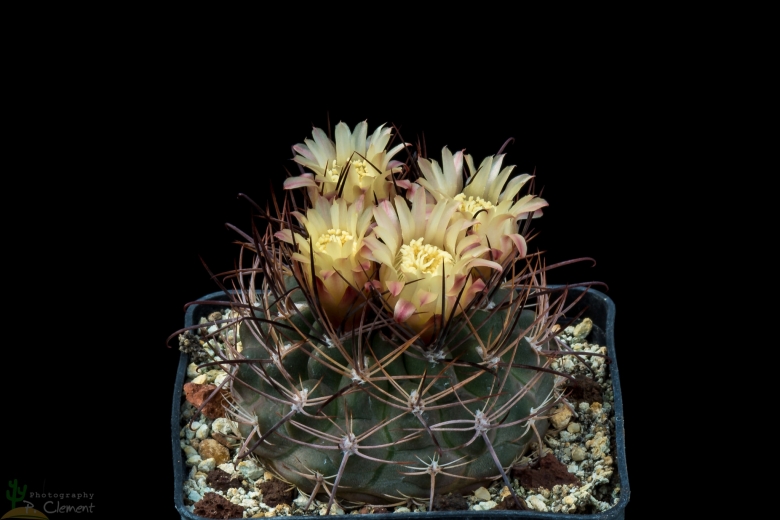Accepted Scientific Name: Neowerdermannia chilensis Backeb.
Cact. Succ. J. (Los Angeles) 8: 5, 73 5 1936.

Rebutia chilensis (Neowerdermannia chilensis) Photo by: Peiffer Clement
Origin and Habitat: Neowerdermannia chilensisSN|22416]]SN|22416]] is found at higher elevations in the Andean precordillera in northern Chile (Iquire, Arica and Parinacota) to the border with Argentina and in Peru (Moquegua). Extent of occurrence less than 5,000 km2. It is known in less than 5 locations. Possibly no more than five locations.
Altitude range: This species grows at elevations of 3,000 to 4,100 metres above sea level.
Habitat and Ecology: The species grows in Andean shrubland on rocky and sandy soils on steep slopes. The species is not very noticeable, reason why it appears scarce, however, it is wide ranging, abundant, especially in dense thickets, and stable. There are no major threats, but part of the range in Chile is potentially threatened by mining. This species reproduces only by means of seeds, which fall from the fruit through a basal pore (hole) that opens by the detachment of it from the areola. The seeds generally remain close to the mother plant.
Synonyms:
See all synonyms of Neowerdermannia chilensis
Common Names include:
SPANISH (Español): Macso, Achacana
Description: Neowerdermannia chilensisSN|22416]]SN|22416]] is a small growing plant of dark body colour with slender spines and creamy-white flowers that at fist glance look a lot like a Neoporteria. The body tapers off into an immense tap root, without the constricted neck that separates the body and tap root found in Wilcoxias, and some Thelocacti. It is very slow growing and the height is less than half the diameter.
Note: Neowerdermannias are closely related with Gymnocalyciums but the "chins" characteristic of the Gymnos are not in evidence, and they could never be mistaken for a Gymno.
Root: Thick tap root.
Stem: Globose to depressed globose, solitary or gregarious dark bluish green, without felt at the apex. When young the contraction of the tap root during the winter used to pull the plant right down into the ground so that it is nearly visible. Often as the plant becomes older the stem elongate.
Ribs: About 15, indistinct, spiralling, broad at the areoles and strongly tuberculate.
Tubercles: Broadly triangular.
Areoles: At the base of upper side of tubercles.
Central spine: One, stiff, erect, not hooked, brown to black.
Radial spines. as many as 20, slender, flexible, straight or somewhat curved, lowermost one long and sometimes hooked, dull yellow to pinkish grey, becoming darker with age, 8-22 mm long.
Flowers: Small, wide funnel-shaped with spreading limb, creamy-white flushed pink. Pericarpel scaly (like in gymnocalyciums) without bristles or spines. Tube short pale to very dark pink.
Fruit: Reddish, small.
Subspecies, varieties, forms and cultivars of plants belonging to the Neowerdermannia chilensis group
Bibliography: Major references and further lectures
1) John Pilbeam “Cacti for the Connoisseur: A Guide for Growers & Collectors” Timber Press, 01 lug 1987
2) Edward Anderson “The Cactus family” Timber Press, Incorporated, 2001
3) James Cullen, Sabina G. Knees, H. Suzanne Cubey "The European Garden Flora Flowering Plants: A Manual for the Identification of Plants Cultivated in Europe, Both Out-of-Doors and Under Glass" Cambridge University Press, 11/August /2011
4) David R Hunt; Nigel P Taylor; Graham Charles; International Cactaceae Systematics Group. "The New Cactus Lexicon" dh books, 2006
5) Succulent Plant Institute. Morden, Surrey “Gymnocalyciums: some observations on the genus” Succulent Plant Institute, 1967
6) Cáceres, F., Faundez, L., Guerrero, P., Saldivia, P. & Walter, H.E. 2013. Neowerdermannia chilensis. The IUCN Red List of Threatened Species 2013: e.T151957A580908. http://dx.doi.org/10.2305/IUCN.UK.2013-1.RLTS.T151957A580908.en. Downloaded on 24 May 2017.
7) Hoffmann, A. and Walter, H. “Cactáceas en la flora silvestre de Chile.” Fundación Claudio Gay, Santiago. 1st edition 1989.
8) Hoffmann, A. and Walter, H. “Cactáceas en la flora silvestre de Chile”. 2nd edition. Ediciones Fundación Claudio Gay, Santiago, Chile. 2004
9) Ritter F. “Kakteen in Südamerika” Band 3 Chile. Spangenberg. 857-1238, 1980.
10) KIESLING R, J. LARROCA, L. FAÚNDEZ, D. METZING & S. ALBESIANO (2008) Cactaceae. In: Zuloaga FO,M Belgrano & O Morrone (eds) “Catálogo de las Plantas Vasculares del Cono Sur (Argentina, Sur de Brasil, Chile, Paraguay y Uruguay). Volume 2. Dicotyledonae: Acanthaceae –Fabaceae (Abarema–Schizolobium)”: 1715-1830. Monographs in Systematic Botany from the Missouri Botanical Garden 107.
11) Eggli U, M. Munoz & B. Leuenberger (1995) “Cactaceae of South America: The Ritter Collections”. Englera 16: 1-646.
12) BELMONTE E., L. FAÚNDEZ, J. FLORES, A. HOFFMANN, M. MUÑOZ & S. TEILLIER (1998) “Categorías de conservación de cactáceas nativas de Chile”. Boletín MNHN 47: 69-89.
13) FICHA DE ANTECEDENTES DE ESPECIE Id especie:539 Neowerdermannia chilensis Backeb. Downloaded on 24 May 2017 from: http://www.mma.gob.cl/clasificacionespecies/fichas8proceso/fichas_finales/Neowerdermania_chilensis_P08_propuesta.pdf










